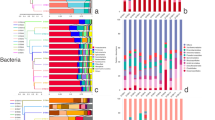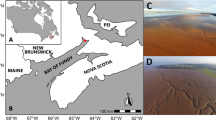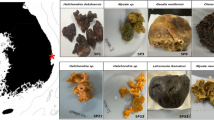Abstract
A distinct subgroup of euglenozoans, referred to as the ‘Symbiontida,’ has been described from oxygen-depleted and sulfidic marine environments. By definition, all members of this group carry epibionts that are intimately associated with underlying mitochondrion-derived organelles beneath the surface of the hosts. We have used molecular phylogenetic and ultrastructural evidence to identify the rod-shaped epibionts of the two members of this group, Calkinsia aureus and B.bacati, hand-picked from the sediments of two separate oxygen-depleted, sulfidic environments. We identify their epibionts as closely related sulfur or sulfide-oxidizing members of the epsilon proteobacteria. The epsilon proteobacteria generally have a significant role in deep-sea habitats as primary colonizers, primary producers and/or in symbiotic associations. The epibionts likely fulfill a role in detoxifying the immediate surrounding environment for these two different hosts. The nearly identical rod-shaped epibionts on these two symbiontid hosts provides evidence for a co-evolutionary history between these two sets of partners. This hypothesis is supported by congruent tree topologies inferred from 18S and 16S rDNA from the hosts and bacterial epibionts, respectively. The eukaryotic hosts likely serve as a motile substrate that delivers the epibionts to the ideal locations with respect to the oxic/anoxic interface, whereby their growth rates can be maximized, perhaps also allowing the host to cultivate a food source. Because symbiontid isolates and additional small subunit rDNA gene sequences from this clade have now been recovered from many locations worldwide, the Symbiontida are likely more widespread and diverse than presently known.
Similar content being viewed by others
Log in or create a free account to read this content
Gain free access to this article, as well as selected content from this journal and more on nature.com
or
Accession codes
References
Amman RI, Ludwig W, Schleifer K-H . (1995). Phylogenetic identification and in situ detection of individual microbial cells without cultivation. Microbiol Rev 59: 143–169.
Atkins MS, Hanna MA, Kupetsky EA, Saito MA, Taylor CD, Wirsen CO . (2002). Tolerance of flagellated protists to high sulfide and metal concentrations potentially encountered at deep-sea hydrothermal vents. Mar Ecol Prog Ser 226: 63–75.
Barbera MJ, Ruiz-Trillo I, Leigh J, Hug LA, Roger AJ (2007). The Diversity of Mitochondrion-Related Organelles Amongst Eukaryotic Microbes, In Origin of mitochondria and hydrogenosomes, Martin WF, Muller, M Eds., Springer, Heidelberg: Germany, pp 239–275.
Barry JP, Greene HG, Orange DL, Baxter CH, Robinson BH, Kochevar RE et al. (1996). Biologic and geologic characteristics of cold seeps in Monterey Bay, California. Deep-Sea Res 43: 1739–1762.
Behnke A, Bunge J, Barger K, Breiner HW, Alla V, Stoeck T . (2006). Microeukaryote community patterns along an O2/H2S gradient in a supersulfidic anoxic Fjord (Framvaren, Norway). Appl Environ Microbiol 72: 3626–3636.
Bernhard JM . (2003). Potential symbionts in bathyal foraminfera. Science 299: 861.
Bernhard JM, Buck KR, Farmer MA, Bowser SS . (2000). The Santa Barbara Basin is a symbiosis oasis. Nature 403: 77–80.
Bernhard JM, Goldstein ST, Bowser SS . (2010). An ectobiont-bearing foraminiferan, Bolivina pacifica, that inhabits micro-oxic pore waters: Cell biological and paleoceanographic insights. Environ Microbiol In press, DOI: 10.1111/j.1462-2920.2009.02073.x.
Bernhard JM, Visscher PT, Bowser SS . (2003). Submillimeter life positions of bacteria, protists, and metazoans in laminated sediments of the Santa Barbara Basin. Limnol Oceanogr 45: 813–828.
Breglia SA, Yubuki N, Hoppenrath M, Leander BS . (2010). Ultrastructure and molecular phylogenetic position of a novel euglenozoan with extrusive episymbiotic bacteria: Bihospites bacati n. gen. et sp. (Symbiontida). BMC Microbiol 10: 145.
Browenkow WW, Cline JD . (1969). Colorimetric determination of dissolved oxygen at low concentrations. Limnol Oceanogr 14: 450–454.
Buck KR, Barry JP . (1998). Monterey Bay cold seep infauna: quantitative comparison of bacterial mat meiofauna with non-seep control sites. Cah Biol Mar 39: 333–335.
Buck KR, Barry JP, Simpson AGB . (2000). Monterey Bay cold seep biota: Euglenozoa with chemoautotrophic bacterial epibionts. Eur J Protistol 36: 117–126.
Buck KR, Bernhard JM (eds). (2002). Protistan-Prokaryotic Symbioses in Deep-Sea Sulfidic Sediments. Kluwer Academic Publishers: Dordrecht, pp 507–517.
Campbell BJ, Engel AS, Porter ML, Takai K . (2006). The versatile epsilon-proteobacteria: key players in sulphidic habitats. Nat Rev Microbiol 4: 458–468.
Cavanaugh CM, Gardiner SL, Jones ML, Jannasch HW, Waterbury JB . (1981). Prokaryotic cells in the hydrothermal vent tube worm Riftia pachyptila Jones: possible chemoautotrophic symbionts. Science 213: 340–341.
Childress JJ, Fisher CR, Favuzzi JA, Kochevar RE, Sanders NK, Alayse AM . (1991). Sulfide-driven autotrophic balance in the bacterial symbiont-containing hydrothermal vent tubeworm, Riftia pachyptila Jones. Biol Bull 180: 135–153.
Cole JR, Chai B, Marsh TL, Farris RJ, Wang Q, Kulam SA et al. (2003). The Ribosomal Database Project (RDP-II): previewing a new autoaligner that allows regular updates and the new prokaryotic taxonomy. Nucleic Acids Res 31: 442–443.
Daims H, Ramsing NB, Schleifer K-H, Wagner M . (2001). Cultivation-independent, semiautomatic determination of absolute bacterial cell numbers in environmental samples by fluorescence in situ hybridization. Appl Environ Microbiol 67: 5810–5818.
Distel DL, Felbeck H . (1988). Pathways of inorganic carbon fixation in the endosymbiont-bearing lucinid clam Lucinoma aequizonata. I. Purification and characterization of endosymbiotic bacteria. J Exp Zool 247: 1–10.
Edgcomb VP, Kysela DT, Teske A, Gomez AD, Sogin ML . (2002). Benthic eukaryotic diversity in the Guaymas Basin hydrothermal vent environment. Proc Natl Sci USA 99: 7658–7662.
Eilers H, Pernthaler J, Glockner FO, Amann R . (2000). Culturability and in situ abundance of pelagic bacteria from the North Sea. Appl Environ Microbiol 66: 3044–3051.
Epstein S, Fowle W, Bazylinski D . (1998). Epibiotic bacteria on several ciliates from marine sediments. J Euk Micro 45: 64–70.
Ewing B, Green P . (1998). Base-calling of automated sequencer traces using phred. II. Error probabilities. Genome Res 8: 186–194.
Ewing B, Hillier L, Wendl MC, Green P . (1998). Base-calling of automated sequencer traces using phred. I. Accuracy assessment. Genome Res 8: 175–185.
Fenchel T, Bernard C, Esteban G, Finlay BJ, Hansen PJ, Iversen N . (1995). Microbial diversity and activity in a Danish fjord with anoxic deep water. Ophelia 43: 45–100.
Fenchel T, Finlay BJ . (1995). Ecology and Evolution in Anoxic Worlds. Oxford University Press: Oxford.
Gevertz DA, Telang G, Voordouw G, Jenneman GE . (2000). Isolation and characterization of strains CVO an FWDO B, two novel nitrate-reducing, sulfide-oxidizing bacteria isolated from oil field brine. Appl Environ Microbiol 66: 2491–2501.
Grieshaber MK, Voelkel S . (1998). Animal adaptations for tolerance and exploitation of poisonous sulfide. Ann Rev Physiol 60: 30–53.
Hagerman L . (1998). Physiological flexibility; a necessity for life in anoxic and sulphidic habitats. Hydrobiologia 376: 241–254.
Hans R, Vopel K, Huettel M, Jorgensen BB . (2009). Sulfide assimilation by ectosymbionts of the sessile ciliate, Zoothamnium niveum. Mar Biol 156: 669–677.
Houf K, De Zutter L, Verbeke B, Van Hoof J, Vandamme P . (2003). Molecular characterization of Arcobacter isolates collected in a poultry slaughterhouse. J Food Prot 66: 364–369.
Kolodziej K, Stoeck T . (2007). Cellular identity of a novel uncultured MAST-12 lineage and phylogeny of the uncultured marine stramenopile sequence clade MAST-12. Appl Environ Microbiol 73: 2718–2726.
Kuwabara JS, van Geen A, McCorkle DC, Bernhard JM . (1999). Dissolved sulfide distributions in the water column and sediment pore waters of the Santa Barbara Basin. Geochim Cosmochim Acta 63: 2199–2209.
Lang-Unnasch N, Reith ME, Munholland J, Barta JR . (1998). Plastids are widespread and ancient in parasites of the phylum Apicomplexa. Int J Parasitol 28: 1743–1754.
Leander BS, Farmer MA . (2000). Epibiotic bacteria and a novel pattern of strip reduction on the pellicle of Euglena helicoideus (Bernhard) Lemmermann. Eur J Protistol 36: 405–413.
Leander BS, Keeling PJ . (2004). Symbiotic innovation in the oxymonad Streblomastix strix. J Eukaryot Microbiol 51: 291–300.
Lin X, Wakeham SG, Putnam IF, Astor YM, Scranton MI, Chistoserdov AY et al. (2006). Comparison of vertical distributions of prokaryotic assemblages in the anoxic Cariaco Basin and Black Sea by use of fluorescence in situ hybridization. Appl Environ Microbiol 72: 2679–2690.
llobet-Brossa E, Rossello-Mora R, Amann R . (1998). Microbial community composition of Wadden Sea sediments as revealed by fluorescence in situ hybridization. Appl Environ Microbiol 64: 2691–2696.
Longnecker K, Reysenbach AL . (2001). Expansion of the geographic distribution of a novel lineage of epsilon-Proteobacteria to a hydrothermal vent site on the Southern East Pacific Rise. FEMS Microbiol Ecol 35: 287–293.
Lucker S, Steger D, Kjeldsen KU, MacGregor BJ, Wagner M, Loy A . (2007). Improved 16S rRNA-targeted probe set for analysis of sulfate-reducing bacteria by fluorescence in situ hybridization. J Microbiol Meth 69: 523–528.
Ludwig W, Strunk O, Westram R, Richter L, Meier H, Yadhukumar et al. (2004). ARB: a software environment for sequence data. Nucleic Acids Res 32: 1363–1371.
Madrid VM, Taylor GT, Scranton MI, Chistoserdov AY . (2001). Phylogenetic diversity of bacterial and archaeal communities in the anoxic zone of the Cariaco Basin. Appl Environ Microbiol 67: 1663–1674.
Manz W, Amann R, Ludwig W, Wagner M, Schleifer K-H . (1992). Phylogenetic oligodeoxynucleotide probes for the major subclasses of proteobacteria—problems and solutions. Syst Appl Microbiol 15: 539–600.
Massana R, Terrado R, Forn I, Lovejoy C, Pedros-Alio C . (2006). Distribution and abundance of uncultured heterotrophic flagellates in the world oceans. Environ Microbiol 8: 1515–1522.
McClung CR, Patriquin DG, Davis RE . (1983). Campylobacter nitrofigilis sp. nov., a nitrogen-fixing bacterium associated with roots of Spartina alterniflora. Int J Syst Bacteriol 33: 605–612.
Muyzer G, Smalla K . (1998). Application of denaturing gradient gel electrophoresis (DGGE) and temperature gradient gel electrophoresis (TGGE) in microbial ecology. Antonie van Leeuwenhoek 73: 127–141.
Naguanuma T, Kato C, Hirayama H, Moriyama N, Hashimoto J, Horikoshi K . (1997). Intracellular occurrence of epsilon-proteobacterial 16S rDNA sequences in the vestimentiferan trophosome. J Oceanogr 53: 193–197.
Neef A . (1997). Vol. PhD thesis TU: Munchen, Germany.
Not F, Latasa M, Scharek R, Viprey M, Karleskind P, Balague V et al. (2008). Protistan assemblages across the Indian Ocean, with a specific emphasis on the picoeukaryotes. Deep-Sea Res I 55: 1456–1473.
Ott JA . (1996). Sulphide ectosymbioses in shallow marine habitats. Mar Ecol Prog Ser 11: 369–382.
Ott JA, Novak R, Schiemer F, Hentschel U, Nebelsick M, Polz M . (2008). Tackling the sulfide gradient: a novel strategy involving marine nematodes and chemoautotrophic ectosymbionts. Mar Ecol 12: 261–279.
Parrino V, Kraus D, Doeller J . (2000). ATP production from the oxidation of sulfide in gill mitochondria of the ribbed mussel Geukensia demissa. J Exp Biol 203: 2209–2218.
Pernthaler A, Pernthaler J, Amann R . (2002). Fluorescence in situ hybridization and catalyzed reporter deposition for the identification of marine bacteria. Appl Env Microbol 68: 3094–3101.
Polz M, Ott JA, Bright M, Cavanaugh CM . (2000). Associations between sulfur-oxidizing bacteria and eukaryotes represent spectacular adaptations to environmental gradients. ASM News 66: 531–539.
Posada D, Crandall KA . (1998). MODELTEST: testing the model of DNA substitution. Bioinformatics 14: 817–818.
Reimers CE, Lange CB, Tabak M, Bernhard JM (1990). Seasonal spillover and varve formation in the Santa Barbara Basin, California. Limnol Oceanog 35: 1577–1585.
Reimers CE, Ruttenberg KC, Canfield DE, Christiansen MB, Martin JB (1996). Pore water pH and authigenic phases formed in the uppermost sediments of the Santa Barbara Basin. Geochim Cosmochim Acta 60: 4037–4057.
Simpson AGB, van den Hoff J, Bernard C, Burton H, Patterson DJ . (1997). The ultrastructure and systematic position of the Euglenozoan Postgaardi mariagerensis, Fenchel et al. Arch Protistenkd 147: 213–225.
Snaidr J, Amann R, Huber I, Ludwig W, Schleifer K-H . (1997). Phylogenetic analysis and in situ identification of bacteria in activated sludge. Appl Environ Microbiol 63: 2884–2896.
Somero GN, Childress JJ, Anderson AE . (1989). Transport, metabolism, and detoxification of hydrogen sulfide in animals from sulfide-rich marine environments. Rev Aquatic Sci 1: 591–614.
Stahl DA, Amann R (eds). (1991). Development and Application of Nucleic Acid Probes in Bacterial Systematics. Wiley & Sons Ltd.: Chichester, England, pp 205–248.
Stamatakis A . (2006). RAxML-VI-HPC: Maximum likelihood-based phylogenetic analyses with thousands of taxa and mixed models. Bioinformatics 22: 2688–2690.
Stamatakis A, Hoover P, Rougemont J . (2008). A rapid bootstrap algorithm for the RAxML Web servers. Syst Biol 57: 758–771.
Stoeck T, Behnke A, Christen R, Amaral-Zettler L, Rodriguez-Mora MJ, Chistoserdov A et al. (2009). Massively parallel tag sequencing reveals the complexity of anaerobic marine protistan communities. BMC Biol 7: 72.
Stoeck T, Hayward B, Taylor GT, Varela R, Epstein SS . (2006). A multiple PCR-primer approach to access the microeukaryotic diversity in environmental samples. Protist 157: 31–43.
Teske A, Sigalevich P, Cohen Y, Muyzer G . (1996). Molecular identification of bacteria from a coculture by denaturing gradient gel electrophoresis of 16S ribosomal DNA fragments as a tool for isolation in pure cultures. Appl Environ Microbiol 62: 4210–4215.
Urbach E, Vergin KL, Young L, Morse A . (2001). Unusual bacterioplankton community structure in ultra-oligotrophic Crater Lake. Limnol Oceanogr 46: 557–572.
Van Dreiessche E, Houf K, Vangroenweghe F, Nollet N, Zutter L, Vandamme P et al. (2004). Occurrence and strain diversity of Arcobacter species isolated from healthy Belgian pigs. Res Microbiol 155: 662–666.
Vismann B . (1991). Sulfide tolerance and detoxification in Arenicola marina and Sipunculus nudus. Am Zool 35: 145–153.
Wallner G, Amman RI, Beisker W . (1993). Optimizing fluorescent in situ hybridization with rRNA-targeted oligonucleotide probes for flow cytometric identification of microorganisms. Cytometry 14: 136–143.
Wirsen CO, Sievert SM, Cavanaugh CM, Molyneaux SJ, Ahmad A, Taylor LT et al. (2002). Characterization of an autotrophic sulfide-oxidizing marine Arcobacter sp. that produces filamentous sulfur. Appl Environ Microbiol 68: 316–325.
Wolowski K . (1995). Dylakosoma pelophilum Skuja, a rare colourless euglenophyte found in Poland. Algol studies 76: 75–78.
Yeates C, Saunders AM, Crocetti GR, Blackall LL . (2003). Limitations of the widely used GAM42a and BET42a probes targeting bacteria in the Gammaproteobacteria radiation. Microbiology 149: 1239–1247.
Yubuki N, Edgcomb VP, Bernhard JM, Leander BS . (2009). Ultrastructure and molecular phylogeny of Calkinsia aureus: cellular identity of a novel clade of deep-sea euglenozoans with epibiotic bacteria. BMC Microbiol 9: 16.
Acknowledgements
We thank the captain and crew of the R/V Robert Gordon Sproul and Richard Sperduto who helped with sampling, Hilary Morrison and Rich Fox (MBL) for the use of their pipeline scripts for sequence data processing, and Matt First who helped with confocal microscopy. VE would like to thank Dagmar Woebkin for helpful discussions about CARD-FISH approaches. This research was supported by a grant from NSF (MCB-0604084) to VE and JMB and by grants from the Tula Foundation (Centre for Microbial Diversity and Evolution) and the National Science and Engineering Research Council of Canada (NSERC 283091-09) to BSL.
Author information
Authors and Affiliations
Corresponding author
Rights and permissions
About this article
Cite this article
Edgcomb, V., Breglia, S., Yubuki, N. et al. Identity of epibiotic bacteria on symbiontid euglenozoans in O2-depleted marine sediments: evidence for symbiont and host co-evolution. ISME J 5, 231–243 (2011). https://doi.org/10.1038/ismej.2010.121
Received:
Revised:
Accepted:
Published:
Issue date:
DOI: https://doi.org/10.1038/ismej.2010.121
Keywords
This article is cited by
-
Single-cell genomics unveils a canonical origin of the diverse mitochondrial genomes of euglenozoans
BMC Biology (2021)
-
Superorganisms of the Protist Kingdom: A New Level of Biological Organization
Foundations of Science (2021)
-
Distribution Patterns of Microeukaryotic Community Between Sediment and Water of the Yellow River Estuary
Current Microbiology (2020)
-
NanoSIMS and tissue autoradiography reveal symbiont carbon fixation and organic carbon transfer to giant ciliate host
The ISME Journal (2018)
-
A novel alphaproteobacterial ectosymbiont promotes the growth of the hydrocarbon-rich green alga Botryococcus braunii
Scientific Reports (2015)



